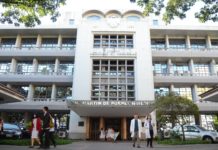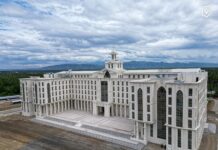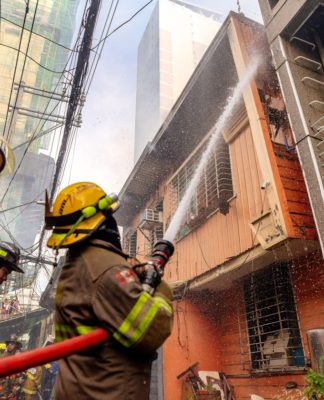National Artist for Visual Arts Arturo Luz died on May 26. He was 94 years old.
His death was announced by his daughter, Angela, in a Facebook post.
Luz studied at the old UST College of Architecture and Fine Arts, where he became a student of the likes of Diosdado Lorenzo, Victorio Edades and Galo Ocampo, before training internationally at the Art School of the Brooklyn Museum in New York and Académie Grade Chaumière in Paris.
In 1997, he was named National Artist Award for Visual Arts, the highest recognition given to Filipino artists.
His earlier works were inclined toward linearity and simplicity. He, later on, shifted to geometric art and abstraction in collages, paintings, prints and sculpture, infused with oriental and Asian sensibilities.
In the 1950s, Luz began to center his works on Philippine life. His formalistic and minimalist approach, combined with his architectural designs, produced a style distinct from his foreign influences like Paul Klee.
His expertise in drawing lines and figures was shown in “Binondo Houses,” a pen and ink on paper from the 1950s. He drew an abstract, geometric “bahay na bato” with narrow, checkered lines on the roof and irregular shapes and curves that served as windows.
In “Imaginary Landscape,” a 2012 painting on graphite and acrylic on canvas, Luz rendered monochromatic leaf- and grass-like figures on a red background, designed with checkered and triangular patterns.
He received several foreign scholarships, including from Spain in 1953, Italy in 1963, and the United States in 1963. He joined various exhibitions abroad, including the Philippine Cultural Exhibition held in New York in 1953, Arte de América y España in 1963, the 11th Sao Paolo Biennale in 1971, the Tokyo International Print Biennale in 1974, and the 8th British International Print Biennale in 1984.
Among his works recognized internationally are the “Candle Vendor” painting, which sold for HK$2 million at a Christie’s auction, and a mural dubbed “Black and White,” which can be seen in the lobby of the Bulwagang Carlos V. Francisco of the Cultural Center of the Philippines.
Luz was one of the founding members of the modern Neo-Realist school in Philippine art, along with Jose Joya, Edades, Vicente Manansala and HR Ocampo.
He was the founding director of the Metropolitan Museum of Manila. He established the Luz Gallery in 1960, which has, according to the National Commission for Culture and the Arts, “inspired and developed a Filipino artistic community that nurtures impeccable designs.”
The University recognized Luz as an alumnus who “paved the way for abstract expressionism in the Philippines,” freed from renowned artist Fernando Amorsolo’s romantic styles.
Former Philippine Daily Inquirer columnist Belinda Olivares-Cunanan shared her special attachment to Luz’s painting, “Cities of the Past, No. 4,” which he did in 1997. It depicts in cubist style the ancient Angkor Wat of Cambodia.
Cunanan said she bought the artwork as a reminder of her late husband who had been Philippine envoy to Cambodia.
“Thanks, Arturo Luz, for this beautiful painting which I shall treasure forever. May you rest in peace in the most significant of the ancient cities. the Lord’s Heavenly Home,” her Facebook post read.
Cesar Devera, an artist based in California who worked under Luz during his stint as director of the Design Center of the Philippines, described him as a “giant of a man.”
Fellow painter Impy Pilapil said, “I hope the next life will be just as blessed.”
Luz, as a National Artist, may be interred at the Libingan ng mga Bayani (Heroes’ Cemetery).
Two Masses were held for the repose of the soul of the National Artist, one on May 27 and another on May 28.
The National Commission for Culture and the Arts announced that preparations for a national tribute for Luz were underway.
His family has yet to release details of his wake and interment.


















